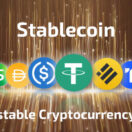Maker is a stablecoin project that aims to provide a decentralized coin to the market with the purpose of reducing the consistent volatility that Ethereum, Bitcoin, and many other altcoins have face. The Dai; a coin developed by the Maker DAO, is stabilized against the value of the US Dollar through a platform built on top of the Ethereum network.
Maker is a smart contract platform that was established as way to offer a stable currency that does not experience the volatility that other cryptos have experienced. The project founders believe that in order for cryptocurrency and blockchain technology to provide its many benefits to society, it must first be rid of the constant price fluctuations its holders experience. In addition, the MKR platform has placed feedback mechanisms and failsafe operations that combat price fluctuations and prevent the company from making out with user funds in bad times.
Maker enables anyone to leverage their Ethereum assets to generate Dai on the Maker Platform. Once funds are generated, Dai can be used in a similar fashion as any other cryptocurrency: it can be freely sent to others, used as a payments method for goods and services, or held as a long term investment. In addition, the generation of Dai coins also creates the infrastructure needed for a much more stable decentralized margin trading platform, where Dai will be proven to be stable and pegged to the US Dollar.
Dai is a complex mechanism that uses market forecasting and expert trading knowledge to reduce volatility in a radically new way. Read the whitepaper for more in-depth descriptions of how they plan to accomplish this.
MKR Value, Market Cap, and Volume
The MakerDAO never ran an ICO, rather, they gradually placed MKR into the market through private deals and Bitshares. MKR is only available through their private market as to ensure security and well-intentioned participants. Through this privatized entrance into the scene, MKR has been able to reach a market cap of over $600 million, with daily trading volumes of nearly $1 million in February of 2018. Due to the unique manner in which MKR and its Dai coin maintain a stable price, they have been able to garner a lot of interest from blockchain and crypto supporters of multiple backgrounds.
How Does MakerDAO Work?
MakerDAO works through collateralized assets and smart contracts. Through MKR, anyone can utilize any type of collateral assets to generate Dai on the MKR platform. These transactions are facilitated and protected by their unique smart contracts called collateralized debt positions, one of the key identifying factors of this stablecoin.
These CDP’s, when generated, create Dai for the users. The CDP’s then hold the collateral assets deposited by the user and allow them to generate Dai, but this also gradually accrues debt as to lock these collateral user assets inside the CDP until it is paid back with the equivalent amount of Dai. Once this amount is equal, the user can then freely withdraw the original assets they deposited. CDP’s that are active were specially programmed by developers to always be in excess of the amount owed, so as to ensure there is never a shortage of funds when users are guaranteed a return.
In order to more clearly understand how these smart contract-based CDP’s function, it is easier to look at how each step works in the process.
Step 1: Creating the CDP and Depositing Collateral
When the user of a CDP first sends a transaction to Maker, the system then sends another transaction to fund it with the amount and type of collateral that will be used to generate Dai. At this point the CDP is considered collateralized and all information related to this transaction is stored on the blockchain.
Step 2: Generating Dai from the Collateralized CDP
The CDP user then sends a transaction to retrieve the amount of Dai they want, and in return the CDP accrues an equivalent amount of debt. This ensures that users cannot fraudulently withdraw their funds before paying back the equivalent amount of Dai.
Step 3: Paying Down the Debt and Stability Fee
When the user wants to retrieve their collateral that was initially deposited, they have to gradually pay off the debt in the CDP, on top of the stability fee that continuously gathers debt over time. The stability fee can only be paid in MKR. Once the user is able to pay down the debt and stability fee, the CDP becomes debt-free and the collateral becomes freed and accessible to the user.
Step 4: Withdrawing collateral and closing the CDP
With the debt and stability fee paid down, the CDP user can freely retrieve all or some of their collateral back to their wallet by activating this transaction through Maker.
Debt and Stability Fee and the Dai Price Stability
At all times, the Maker platform has a “target” price that the Dai coin is set at. This price has multiple functions, including the calculation of the collateral-to-debt ratio that users will experience when acquiring Dai as well as determining the value of the collateralized assets that users deposit. This price is the backbone of how Dai is able to decrease price volatility and ensure users can have peace of mind that their collateral as well as the Dai coin will retain its value.
The MKR platform also has several failsafe stability protocols in place to further ensure a secure and non-volatile environment for holders of value on their platform.
Target Rate Feedback Mechanism
The TRFM is the automatic mechanism by which the Dai Stablecoin System adjusts the target rate in order to maintain stability of the Dai market price compared to the target price. When the TRFM is in effect, both the target rate and the target price change dynamically, as needed, to balance the supply and demand of Dai by automatically adjusting user incentives for generating and holding Dai. The feedback mechanism pushes the market price of Dai towards the desired target price, reducing volatility and providing liquidity to users during high-risk periods of time.
When the market price of Dai is below the target price, the target rate increases. This causes the target price to increase at a higher rate, causing generation of Dai with CDPs to become more expensive. At the same time, the increased rate causes the profits made from holding Dai to increase, leading to a corresponding increase in demand. This combination of reduced supply and increased demand causes the Dai market price to increase and stabilize back to the desired target price. This mechanism gives users freedom to combat the price volatility and incentivizes and utilizes its users to keep Dai stable.
Sensitivity Parameter
The TRFM’s Sensitivity Parameter is a factor that is used to determine the magnitude of the target rate change in response to Dai volatility in either direction. Holders of MKR can vote to set this rate, but when TRFM is active, the parameter is set by the true market dynamics that are being experienced at any given time. This parameter is key in order to keep the rate change for users at a level that reduces overall volatility, despite outside market conditions.
Global Settlement
Global settlement is a sort of failsafe option that MKR created in order to further guarantee that they could never remove user funds from the system. When activated, the MKR platform would be gradually disintegrated, and all of the funds that users are entitled to would be instantly returned. The process is fully decentralized, and MKR voters govern access to it to ensure that it is only used in case of serious emergencies. Examples of serious emergencies are long term market irrationality, hacking or security breaches, and system upgrades.
MKR is a next-generation stablecoin that has created its own unique path in the market. No other stablecoin has as many failsafe operations and volatility-dampening processes that can provide users with the consistent data and feedback mechanisms to keep them updated on the status of the network. With a decentralized governing system, the platform guarantees that it is not a pump-and-dump scheme.
Stablecoins are a popular trend lately, and the MKR project is one that has gone above and beyond to provide a truly stable and secure coin. Time will tell if this stablecoin will be able to combat price volatility and provide users with a more stable cryptocurrency market and trading environment.






